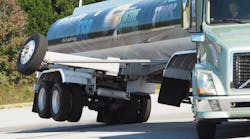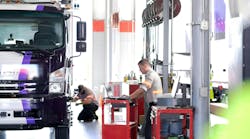Self-driving trucks are an attention-getting image — and a problematic oversimplification, pointed out Bendix Commercial Vehicle Systems. The phrase pops up more and more often in the commercial vehicle industry and media conversations here and around the world, but Bendix stressed that "delivering advanced automated technologies involves more than just technology."
Bendix has continued to share its insight and encourage discussion of the automated/ autonomous "ecosystem," or the complex and evolving environment in which today's advanced commercial vehicle safety systems are being developed, manufactured and adopted. Taking part in recent events around the United States, Bendix emphasized that there's a need for deeper understanding of key factors across the full range of participants in the commercial vehicle and transportation industries.
"It's not just a matter of adding new equipment to a truck and flipping a switch," said Fred Andersky, Bendix's director of government and industry affairs. "The technology will continue to advance, and there is definitely more automation on the way, but we're going to be talking about driver assistance — not driver replacement — for quite a while yet. The various elements that come into play, from the technology to the customer to the overall industry to regulatory oversight, are all interconnected. And they'll all need to be clicking together before this ecosystem is ready to handle a fully driverless vehicle."
'No overnight leaps'
Bendix said it's important to recognize what works over "whiz-bang": A technology demonstration is one thing, but effectively commercializing autonomous vehicle technology to improve highway safety is entirely another.
No matter how automated/autonomous systems evolve, safety is paramount, Bendix contended. Eagerness to put technology in the marketplace must not override the need for it to work properly and improve vehicle and highway safety.
"Whether we're talking about collision mitigation or wirelessly linked platooning, we shouldn't expect overnight leaps forward when it comes to advanced driver assistance systems on the roads," Andersky said. "It's evolution, not revolution. We improve sensor technology; we fuse input from cameras and radar together and integrate the data with more computing power; we tackle connectivity and data issues. Each step requires rigorous research, testing, and real-world use and feedback."
More to overcome
Even the most impressive technology needs to deliver the user a measurable return on investment for the tech to make a widespread difference. And while fuel, labor and tires continue to be major cost factors to fleets, other significant considerations in today's environment include maintenance and uptime, accident reduction and insurance, and driver satisfaction.
As more highly automated technologies like truck platooning prove their worth, increased usage can also help shift the landscape, according to Bendix. Well before this year's mandate requiring electronic stability control on the majority of new Class 7 and 8 trucks, most major North American truck manufacturers were already offering it as standard equipment, based on customer demand. Not only has this had the effect of lowering the initial investment cost in the system, it also helps pave the way for further safety advancements as fleets and drivers enjoy the benefits of the foundational technology.
Although the National Highway Traffic Safety Administration's (NHTSA) electronic stability control rule went into effect Aug. 1, Bendix noted that the Trump administration has required the elimination of two federal rules for every new one added. As a result, NHTSA has introduced the possibility of dropping the full-stability mandate — which Bendix said would hinder the quest for safer highways across North America — which adds a measure of uncertainty to the automated/ autonomous vehicle ecosystem.
No commercial vehicle safety technology replaces a skilled, alert driver exercising safe driving techniques and proactive, comprehensive driver training, Andersky added. Responsibility for the safe operation of the vehicle remains with the driver at all times.
For more on Bendix's advanced safety products, visit www.safertrucks.com/solutions.



